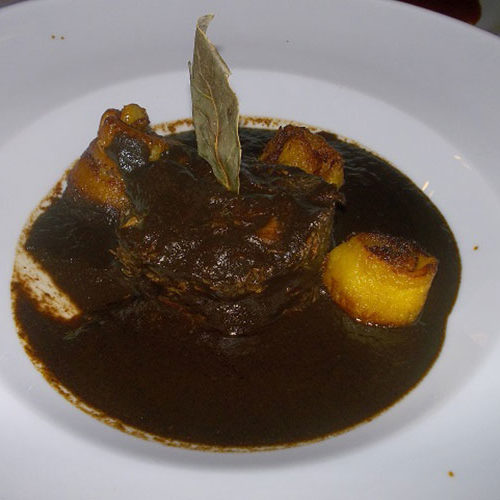Mole negro is the state dish of Oaxaca, the king of moles. It also happens to be the most difficult to make. People pride themselves on their own different touches, and family recipes are passed down as heirlooms. Market stands specializing in moles all proclaim that their version is the best.
This recipe is an adaptation of a version made by my friend and culinary mentor Zoyla Mendoza, who has given me much insight into the cooking of the Valley Zapotecs. When she made it for me at her home in Teotitlán del Valle, she first toasted the chiles, nuts, and spices and sent them out to a nearby mill to be ground. Meanwhile she pounded the tomatoes and other moist ingredients in her big stone mortar, to be combined later with the nut and spice paste. Less sweet than many other versions, her mole negro is spicy and intense — I love the sprightly taste of fresh ginger. Increase the amount of clove and thyme in the recipe if you wish. Zoyla used much more of both than I do.
Though Zoyla’s version of mole negro is less complex than some, it shows the crucial “blackening” feature of most black moles. For years I’d made versions that turned out no blacker than dark red. An offhand remark revealed what I was doing wrong. “Queman los chiles,” (“They burn the chiles,”) a Juchitecan woman casually told me when I asked her. My instinct said that it would turn the whole dish bitter, so I’d just been toasting the chiles lightly. But in Oaxaca it is normal to make mole negro by first separating the seeds from the dried chiles, then toasting the chiles to an absolute crisp and literally burning the seeds. Zoyla also follows this procedure. The bitterness disappears through soaking and extended cooking.
Because the pungent fumes can leave you gasping and call down the wrath of neighbors in city apartment buildings it is wise to attempt this recipe only if you can do the worst part (burning the seeds) outdoors or with a good exhaust fan going full blast. You should also work out an advance plan for the final grinding of the paste. You can either combine all the ingredients and process them in several batches in the blender or assign part of the task (the chiles, nuts, and spices that Zoyla sent out to the mill) to the food processor. Read the recipe through carefully in advance, and decide which strategy you prefer. (The processor alone will definitely give the wrong texture.)

Teotitlán-Style Black Mole (Mole negro de Teotitlán)
Ingredients
- 4 ounces ancho chiles
- 4 ounces guajillo chiles
- 1 thick day-old slice brioche or challah
- ⅓ cup pecan meats
- ¼ cup blanched almonds
- 4 cloves garlic unpeeled
- 1 large white onion unpeeled, or 2 medium-size
- 1 large ripe tomato
- 4 ounces tomatillos with husks
- ⅔ cup (about 4 ounces) sesame seeds
- 7 tablespoons lard, preferably
home-rendered - 1 6- inch piece
canela - ½ bunch thyme (about 2 dozen sprigs) or 2 teaspoons dried, crumbled
- ¼ cup dried Oaxacan oregano or 1 teaspoon dried Mexican oregano, crumbled
- 16 cloves
- 14 allspice berries
- ¼ teaspoon freshly grated nutmeg
- 1 1-inch piece fresh ginger peeled and minced
- 1 cup dark raisins
- 2-4 cups homemade chicken stock or as necessary
Instructions
- The day before beginning the sauce, remove the stems and tops from the chiles; carefully shake out and reserve the seeds. Rinse the chiles under cold running water. Spread them out in a single layer where they can dry completely. Let stand until the next day, turning occasionally and checking to be sure not a drop of moisture remains.
- Crush the bread to fine crumbs or grind in a food processor. You should have about 1 cup. Set aside.
- Preheat the oven to 350°F. Spread the chiles (they must be bone-dry) in one layer on a baking sheet. Toast them in the oven, turning frequently, until crisp and deeply blackened, about 20 minutes. Let the chiles stand at room temperature until completely cooled.
- Spread the pecans and almonds on a baking sheet. Toast them in the oven until golden brown, about 10 minutes. Set aside.
- Place the crisp toasted chiles in a food processor and process until finely ground. Set aside.
- On a griddle or in a small cast-iron skillet, heat the reserved chile seeds over high heat, shaking the pan occasionally, until thoroughly charred and black on all sides, about 5 minutes. (Because of the fumes, this is best done outdoors if you have the means. You can speed the process by sprinkling a few drops of vegetable oil over the seeds and igniting with a match, taking care to shield your face and stand well back from the flame.) Place the charred seeds in a bowl, cover with at least 2 cups cold water, and soak for 1½ hours, changing the water twice. Drain and set aside.
- Heat a griddle or medium-size cast-iron skillet over low heat. Working in sequence, roast the garlic, onion, tomatoes, and tomatillos, removing each kind as it is done and setting it aside in a separate small bowl. When they are cool enough to handle, remove the husks from the tomatillos and peel the rest, making sure to save the juices.
- Place the sesame seeds in a medium-size heavy skillet over medium heat and toast just until golden, stirring constantly and shaking the pan. Immediately scrape out the seeds into a small bowl to stop the cooking. Set aside.
- In a small heavy skillet, heat 1 tablespoon lard over medium-high heat until rippling. Add the canela, thyme, oregano, cloves, allspice, nutmeg and ginger. Fry the spices, stirring constantly, until fragrant, about 2 minutes. Set aside.
- In a small skillet, heat another 2 tablespoons lard over medium heat until rippling. Add the raisins and bread crumbs; cook, stirring, until the raisins are puffed and the bread lightly colored, about 2 minutes. Set aside.
- Now you are ready to purée all the ingredients, using either a blender/food processor combination or a blender alone.
- If using both machines, place the pecans, almonds, sesame seeds, bread-raisin mixture, ground chiles, and drained chile seeds in the food processor (working in batches as necessary). Process to a smooth purée. Next, place the fried spices, peeled garlic, onion, tomatoes, and tomatillos in the blender and process to a smooth purée. Combine the two mixtures in a large bowl.
- If using only a blender, line up all the prepared ingredients next to the machine on the counter, place some of each in the blender container, add a few tablespoons chicken stock, and process until smooth, adding more stock as necessary to facilitate blending. (This method requires great patience; small batches will be well puréed in 1-2 minutes while large ones may retain coarse bits of the spices. If thoroughly processed, the mixture will not require sieving, so try not to rush things.) Pour each batch into a bowl as it is done and proceed with the next batch.
- In a large, heavy saucepan or Dutch oven, heat the remaining 4 tablespoons lard over high heat until rippling. Add the purée, all at once, watching for splatters, and reduce the heat to medium-low. Cover and cook, stirring frequently, until the harshness of the chiles is mellowed, 25-30 minutes.
- The mole should now be a heavy paste like a thick frosting mixture. It can be stored for later use or used at once. In either case, it should be thinned before further cooking. Place the paste in the blender when ready to thin it; add 1 cup chicken stock (or as necessary) and process to combine thoroughly.

